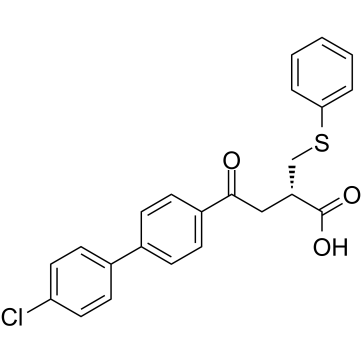179545-77-8
| Name | Tanomastat |
|---|---|
| Synonyms |
BAY12-9566,(S)-4Chloro-g-oxo-a-[(phenylthio)methyl][1,1biphenyl]-4-butanoicAcid
(S)-4-[4-(4-Chlorophenyl)phenyl]-4-oxo-2-(phenylsulfanylmethyl)butanoic acid (S)-4'-Chloro-g-oxo-a-[(phenylthio)methyl][1,1'-biphenyl]-4-butanoic acid |
| Description | Tanomastat (BAY 12-9566) is an orally bioavailable, non-peptidic biphenyl matrix metalloproteinases (MMPs) inhibitor with a Zn-binding carboxyl group. The Ki values are 11, 143, 301, and 1470 nM for MMP-2, MMP-3, MMP-9, MMP-13 respectively. Tanomastat shows anti-invasive and antimetastatic activity in several experimental tumor models[1][2][3]. |
|---|---|
| Related Catalog | |
| Target |
MMP-2:11 nM (Ki) MMP-3:143 nM (Ki) MMP-9:301 nM (Ki) MMP-13:1470 nM (Ki) |
| In Vitro | Tanomastat (BAY 12-9566) (1-10000 nM; 6 hours) prevents matrix invasion by endothelial cells in a concentration-dependent manner (IC50=840 nM), without affecting cell proliferation[2]. Tanomastat (BAY 12-9566) (1-00 µM; 5 days) inhibits tubule formation completely at 15-100 µM[3]. |
| In Vivo | Tanomastat (BAY 12-9566) (100 mg/kg; p.o.; daily for a 7-week period) inhibits local tumor regrowth without causing any toxic effect, and inhibits the number and volume of lung metastases[3]. Animal Model: Six- to eight-week-old female BALB/c nude mice (bearing MDA-MB-435 cells)[3] Dosage: 100 mg/kg Administration: p.o.; daily for a 7-week period Result: Inhibited local tumor regrowth by 58% without causing any toxic effect, and inhibited the number and volume of lung metastases by 57 and 88%, respectively. |
| References |
| Density | 1.33g/cm3 |
|---|---|
| Boiling Point | 620.1ºC at 760 mmHg |
| Melting Point | 110-110.5ºC |
| Molecular Formula | C23H19ClO3S |
| Molecular Weight | 410.91300 |
| Flash Point | 328.8ºC |
| Exact Mass | 410.07400 |
| PSA | 79.67000 |
| LogP | 6.07290 |
| Vapour Pressure | 3.07E-16mmHg at 25°C |
| Index of Refraction | 1.662 |
| Hazard Codes | Xi |
|---|
